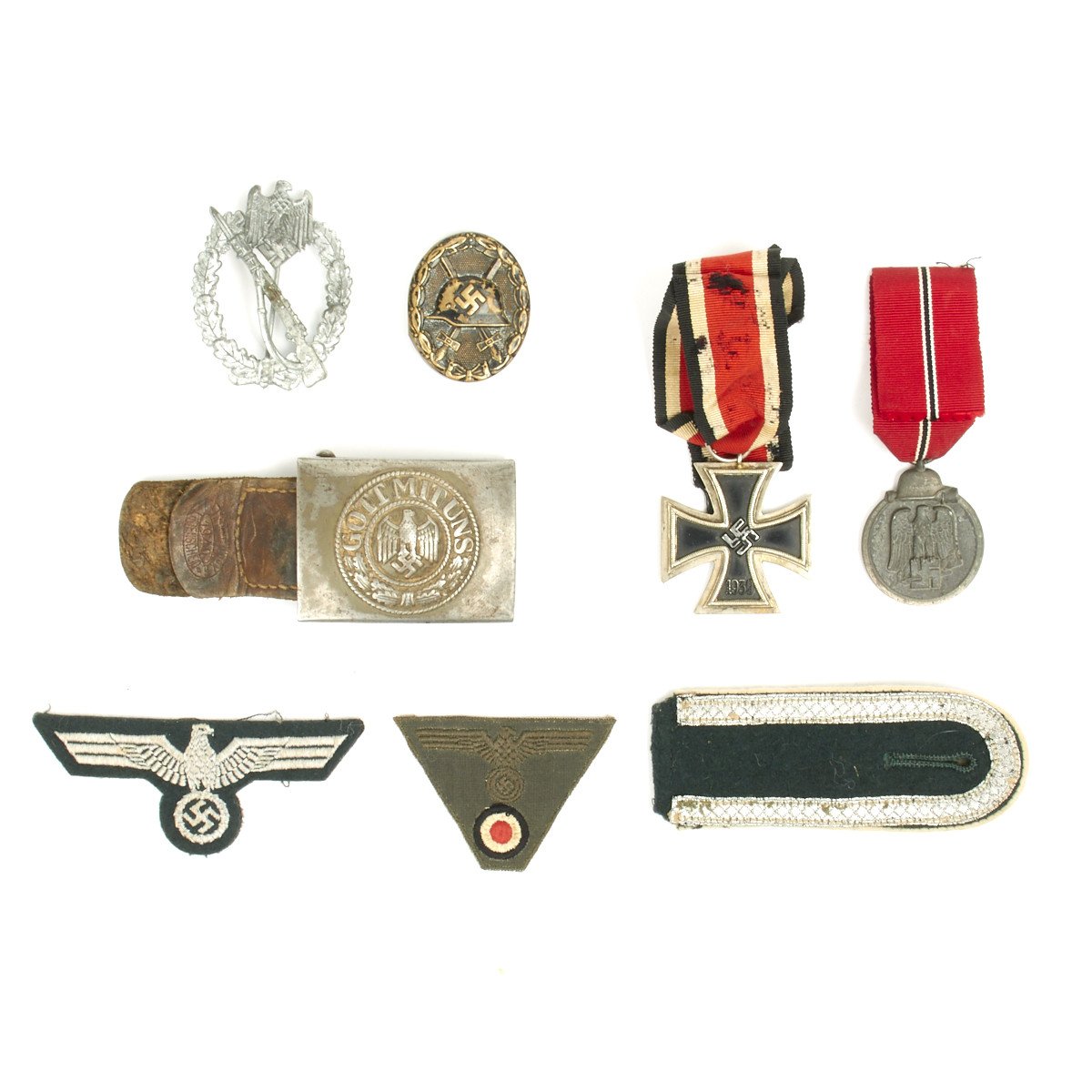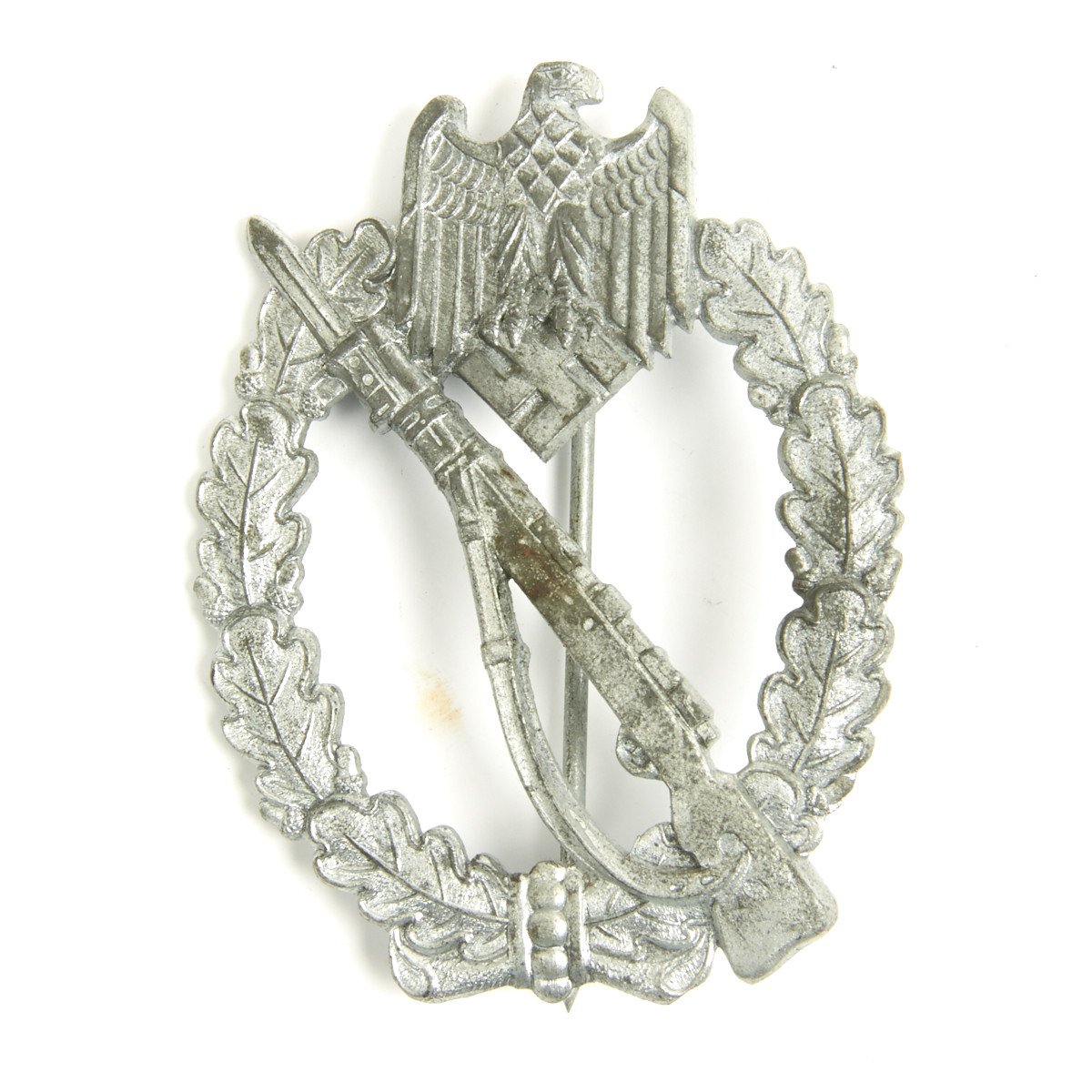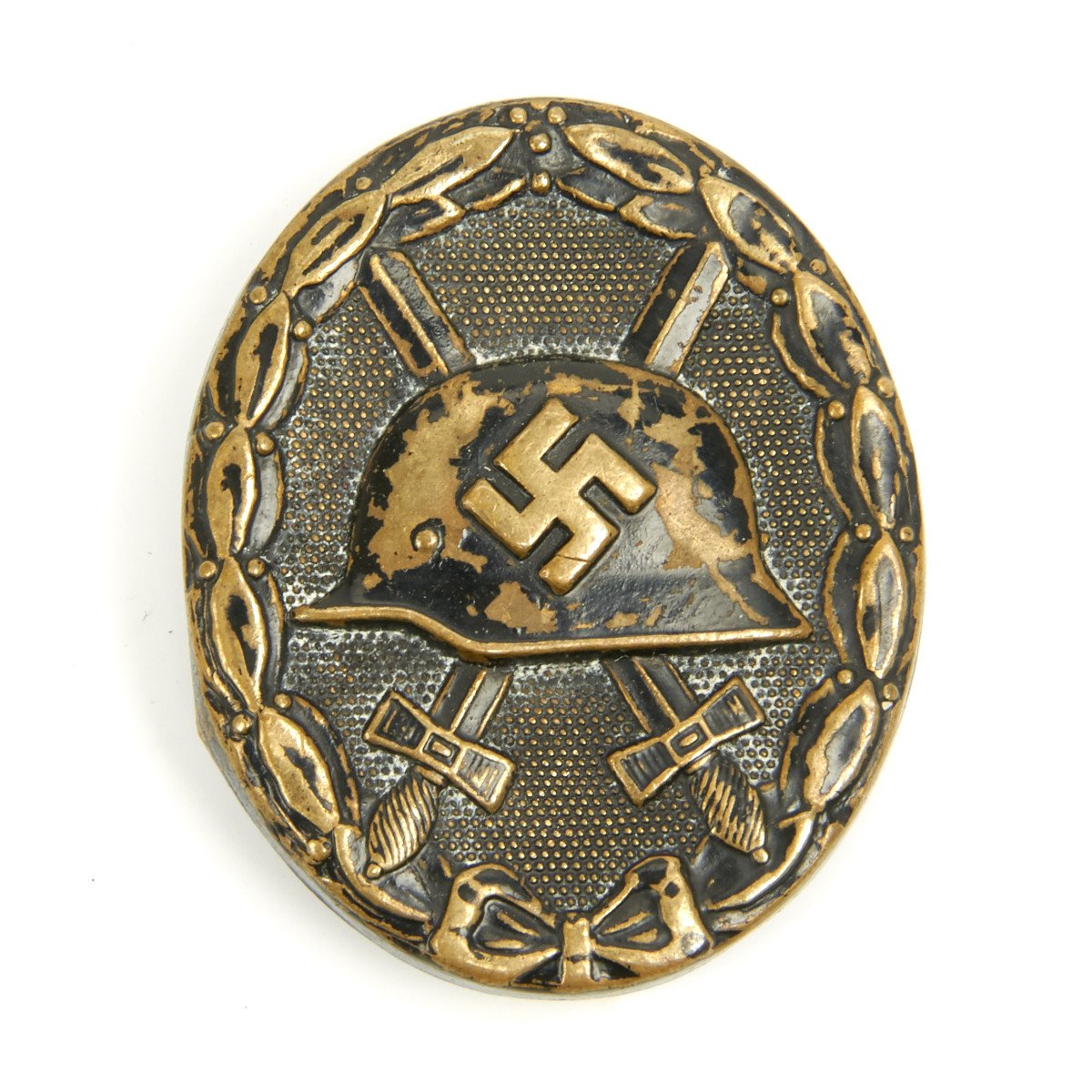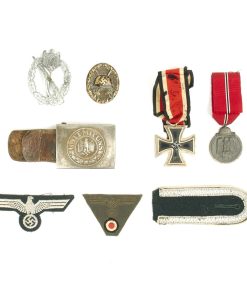Original German WWII Heer Army Medal and Insignia Grouping Original Items
$ 695,00 $ 208,50
Original Items: Only One Set Available. The German Army (German: Heer) was the land forces component of the Wehrmacht, the regular German Armed Forces, from 1935 until it was demobilized and later dissolved in August 1946.The Wehrmacht also included the Kriegsmarine (Navy) and the Luftwaffe (Air Force). During World War II, a total of about 13 million soldiers served in the German Army. Most army personnel were conscripted.
Only 17 months after Adolf AH announced publicly the rearmament program, the Army reached its projected goal of 36 divisions. During the autumn of 1937, two more corps were formed. In 1938, four additional corps were formed with the inclusion of the five divisions of the Austrian Army after the Anschluss in March. During the period of its expansion by Adolf AH, the German Army continued to develop concepts pioneered during World War I, combining ground (Heer) and air (Luftwaffe) assets into combined arms teams. Coupled with operational and tactical methods such as encirclement and the “battle of annihilation”, the German military managed quick victories in the two initial years of World War II, prompting the use of the word Blitzkrieg (literally lightning war, meaning lightning-fast war) for the techniques used.
The German Army entered the war with a majority of its infantry formations relying on horse-drawn transport. The infantry remained foot soldiers throughout the war; artillery also remained primarily horse-drawn. The motorized formations received much attention in the world press in the opening years of the war, and were cited as the main reason for the success of the German invasions of Poland (September 1939), Norway and Denmark (April 1940), Belgium, France and Netherlands (May 1940), Yugoslavia (April 1941) and Operation Barbarossa, the invasion of the Soviet Union (June 1941). However their motorized and tank formations accounted for only 20% of the Heer’s capacity at their peak strength. The army’s lack of trucks (and petroleum to run them) was a severe handicap to infantry movement especially during and after the Normandy invasion when Allied air power devastated the French rail network north of the Loire.
The following grouping consists of awards and insignia given to a solider in the German Army (Heer) during WW2. Every part of this set is 100% authentic (no reproductions) and in good to very good condition. The set is comprised as follows:
– Iron Cross 2nd Class (Eisernes Kreuz 2. Klasse – abbreviated as EK 2 or E.K.2.) The Iron Cross was awarded for bravery in battle as well as other military contributions in a battlefield environment.
– Infantry Assault Badge in Silver. The Infantry Assault Badge (German: Infanterie-Sturmabzeichen) was a German war badge awarded to Waffen SS and Wehrmacht Heer soldiers during the Second World War. This decoration was instituted on 20 December 1939 by the Commander-in-Chief of the German Army, Generalfeldmarschall Walther von Brauchitsch. It could be awarded to members of non-motorized Infantry units and units of the Gebirgsjäger that had participated in Infantry assaults, with light Infantry weapons, on at least three days of battle in the front line on or after 1 January 1940. When a counter offensive led to fighting, it could also apply. Award of the Infantry Assault Badge was authorized at regimental command level. The silver class was instituted on 20 December 1939 by the commander of the OKH, Walther von Brauchitsch, and was awarded to infantry soldiers according to one of the following criteria: To have taken part in at least three: infantry assaults (including counter-attacks) or at least three armed reconnaissance operations or engaged in hand-to-hand combat in an assault position or participated on three separate days in the restitution of combat positions.
– Early War Black Wound Badge. The Wound Badge (German: Verwundetenabzeichen) was a military decoration first promulgated by Wilhelm II, German Emperor on 3 March 1918, which was awarded to wounded or frostbitten soldiers of the Imperial German Army, during World War I. Between the world wars, it was awarded to members of the German armed forces who fought on the Nationalist side of the Spanish Civil War, 193839, and received combat related wounds. It was awarded to members in the Reichswehr, the Wehrmacht, SS and the auxiliary service organizations during the Second World War. After March 1943, due to the increasing number of Allied bombings, it was also awarded to wounded civilians in air raids. It was awarded when the wound was the result of enemy hostile action, with an exception being for frost-bite.
– Eastern Front Medal. The Eastern Front Medal (German: Medaille Winterschlacht im Osten 1941/42) was a World War II German military decoration awarded to both German and Axis personnel. It was for those who served on the German Eastern Front during the “first winter campaign” period of 15 November 1941 to 15 April 1942. It was instituted on 26 May 1942 and was commonly known as the Ostmedaille (East Medal). Geographic limits were placed on its award of east of Ukraine and Ostland or in the Finnland area, east of the 1940 Russo/Finnish border. It was officially decommissioned by Oberkommando der Wehrmacht on 4 September 1944. The medal was wryly called the Frozen Meat Medal or the “Order of the Frozen Flesh” (German: Gefrierfleischorden) by Heer, Luftwaffe and Waffen-SS personnel to whom it was awarded. They qualified for the badge after a minimum of 14 days served in active combat; 30 days of flying personnel over enemy held land; 60 days of continuous service in a “combat zone”; being wounded or suffering a “frozen limb”, severe enough to warrant the issue of a Wound Badge.
– Steel Infantry Belt Buckle. Reads GOTT MIT UNS (God is with us) includes leather belt tab. The buckle is dated 1940 and is maker coded.
– Embroidered Breast Eagle. Embroidered breast eagle, grey thread embroidered on green wool for Army uniforms.
– NCO Infantry Shoulder Board Silver surround on green wool for Army uniforms.
– Late war model 43 cap insignia Embroidered on dark background.
A wonderful totally genuine grouping perfect for the WW2 German collector.
Fast Shipping with Professional Packaging
Thanks to our longstanding association with UPS FedEx DHL, and other major international carriers, we are able to provide a range of shipping options. Our warehouse staff is expertly trained and will wrap your products according to our exact and precise specifications. Prior to shipping, your goods will be thoroughly examined and securely secured. We ship to thousands clients each day across multiple countries. This shows how we're dedicated to be the largest retailer on the internet. Warehouses and distribution centres can be located throughout Europe as well as the USA.
Note: Orders with more than one item will be assigned a processing date depending on the item.
Before shipping before shipping, we'll conduct a thorough inspection of the items you have ordered. Today, the majority of orders will be delivered within 48 hours. The delivery time will be between 3-7 days.
Returns
The stock is dynamic and we cannot completely manage it because multiple stakeholders are involved, including our factory and warehouse. So the actual stock may alter at any time. It's possible that you may not receive your order once the order has been made.
Our policy is valid for a period of 30 days. If you don't receive the product within 30 days, we are not able to issue a refund or an exchange.
You can only return an item if it is unused and in the same state as the day you received it. You must have the item in its original packaging.
Related products
Uncategorized
Uncategorized
Uncategorized
Armoured Fighting Vehicles of the World: AFVs of World War One (Hardcover Book) New Made Items
Uncategorized
Uncategorized
Uncategorized
Uncategorized
Uncategorized
Uncategorized
Uncategorized
Uncategorized
Uncategorized
Uncategorized
Uncategorized
Uncategorized
Uncategorized
Uncategorized












































































